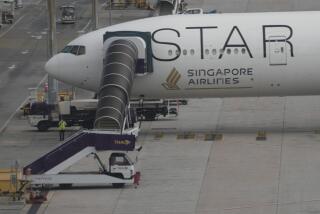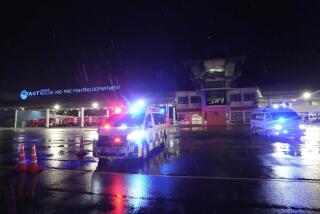Malaysia Airlines Flight 370: Missing plane defies search technology

BEIJING — Despite a wealth of technology, crews trying to find the missing Malaysia Airlines jetliner must cover a large swath of the South China Sea that varies widely in depth and is subject to fast-moving currents that could carry debris more than 50 miles a day, experts say.
The search for the missing Boeing 777 off the southern coast of Vietnam had yielded nothing by early Tuesday. Malaysian and Vietnamese authorities said they had yet to find anything linked to the airliner that carried 239 passengers and crew, and that the search area was being expanded and the operation “intensified.”
Experts said wreckage could be sitting in water as shallow as 300 feet or as deep as 3,000 feet or more, where the ocean is pitch-black and the temperature is as low as 40 degrees. GPS signals are not effective in salt water and acoustic signals sent from the plane’s emergency beacon could be faint.
“Shallow doesn’t necessarily mean easy,” said David Gallo, who managed search expeditions for Air France Flight 447 that crashed into the Atlantic Ocean in 2009.
“I can tell you, having been out there ... on a number of occasions, that the ocean becomes a big place when you’re looking for an aircraft,” he said.
The last known point of radar contact with the Boeing 777 was midway between Malaysia’s east coast and the southern tip of Vietnam. Search crews from 10 countries are scouring 10,500 square miles, including the Gulf of Thailand and its currents.
The first step involves sending crews to a likely impact point, where they lower listening devices into the ocean and attempt to pick up the signals from a device called a “pinger” attached to the plane’s two black boxes. Battery life of the devices is about 30 days.
Gallo, director of special operations at Woods Hole Oceanographic Institution in Massachusetts, said the device was not likely to work as well in shallow water where noise from ships could drown it out.
Search crews are probably “plowing” the ocean floor with sonar, he said, and having that many people involved in the hunt could lead to confusion.
“A search is like a symphony,” he said. “You need all the members on the team to play the right notes at the same time.”
It took searchers five days to find wreckage of the Air France flight and two years to retrieve its black boxes from a depth of about 13,000 feet.
Modern planes, such as the 11-year-old Malaysia Airlines jet that dropped off radar screens Saturday, have technologies that help personnel on the ground learn where the plane is and how it is operating.
When the Air France plane went down, it sent out a series of automated messages about abnormalities to Air France’s maintenance department in the minutes before the crash. The initial event was the simultaneous failure of three sensors that determine airspeed.
The most crucial data about the flight, however, stay on the plane.
Two black boxes record flight data and the voices of the pilots. Debris from the Malaysia Airlines plane could have been pushed miles from the impact point already by wind and ocean currents.
R. Kipp Shearman, an Oregon State University associate professor who studies currents in the South China Sea, said the ocean in the probable crash area was influenced by monsoons and currents that can push floating debris 50 nautical miles in a day.
“March is a period of transition, so the flows can be unpredictable,” he said.
With no physical evidence from the aircraft, attention was focused on the fact that two passengers had used stolen passports, one Italian, one Austrian, to board the plane.
Malaysian authorities, who said earlier that they had closed-circuit video recordings of the passengers, revealed Monday that they had identified one of the two men who used the passports.
“I can confirm that he is not a Malaysian, but cannot divulge which country he is from yet,” Tan Sri Khalid Abu Bakar told the Star, a major Malaysian newspaper. He added that the man was also not from Xinjiang, China — a northwestern province of the mainland that is home to minority Uighurs.
Azharuddin Abdul Rahman, Malaysia’s civil aviation chief, said the two men were “not Asian-looking.”
That dampened speculation that Uighur separatists might have been behind the jet’s disappearance. Uighur separatists have been blamed for a knifing rampage in southwestern China this month that left 29 people dead.
Security authorities have cautioned that use of stolen or forged passports is more frequent than commonly assumed and does not necessarily indicate that terrorist forces might have been involved in the plane’s disappearance.
Adding to concerns that foul play might be involved, however, a Taiwanese official said that officials received an anonymous tip last week warning terrorists were targeting Beijing’s international airport.
But the official, Cai Desheng, chief of Taiwan’s national security bureau, told Taiwan’s official news agency that the call received by his agency March 4 was “not likely’’ to be linked to the mysterious disappearance four days later of the flight from Kuala Lumpur, the Malaysian capital, to Beijing.
Malaysian authorities say they have ruled nothing out as a cause of the disappearance. Nevertheless, the anonymous call was one of dozens of possibly inconsequential clues that investigators are examining as they struggle to explain how the flight simply vanished.
The missing aboard the Malaysia Airlines flight included more than 150 mainland Chinese.
Among those glued to the news reports on Monday was Zhu Daoping, watching for some hint of the fate of his longtime friend and colleague Liu Rusheng, an accomplished calligrapher from Nanjing, China, who also excelled at painting birds and flowers. Liu and his wife were aboard Malaysia Airlines Flight 370 early Saturday after a cultural exchange trip to Kuala Lumpur with a group of Chinese artists.
“I’m very anxious — I just keep watching the news,” Zhu said. “First, they say they found a door, then they say it’s not true. Then they say maybe it’s a terror attack, then they say, let’s not speculate.”
With nerves fraying at a hotel near the Beijing airport where families had been told to gather, Chinese authorities urged Malaysia to step up efforts to find the missing jet.
“We hope Malaysia can fully understand China, especially the mood of the Chinese passengers’ families, and speed up investigation, search and rescue efforts,” Foreign Ministry spokesman Qin Gang said.
Tommy Yang and Nicole Liu of The Times’ Beijing bureau contributed to this report.
More to Read
Sign up for Essential California
The most important California stories and recommendations in your inbox every morning.
You may occasionally receive promotional content from the Los Angeles Times.












